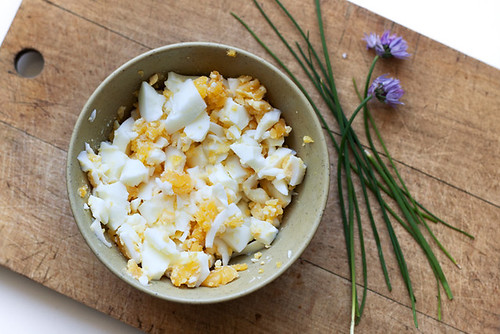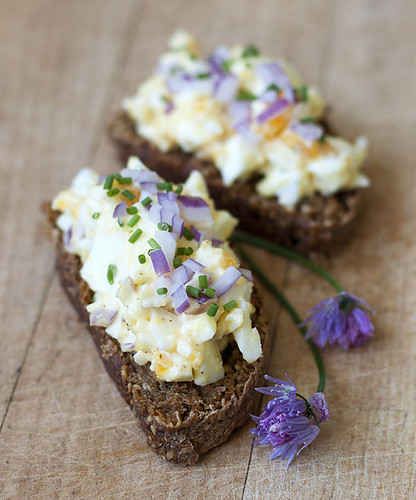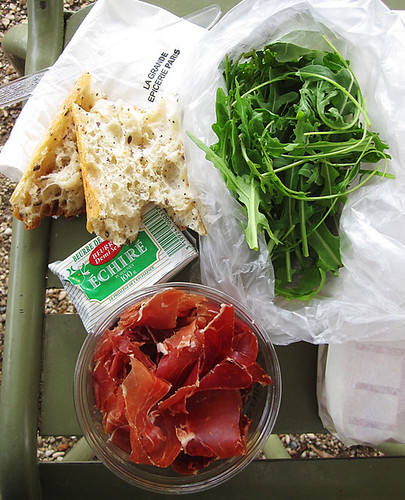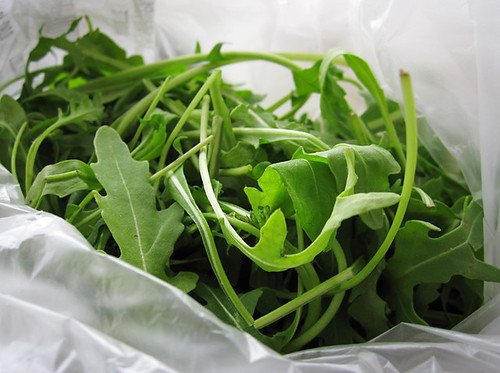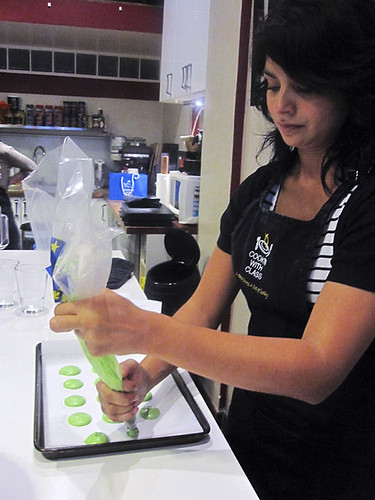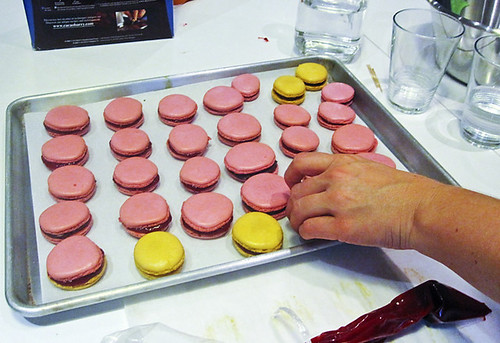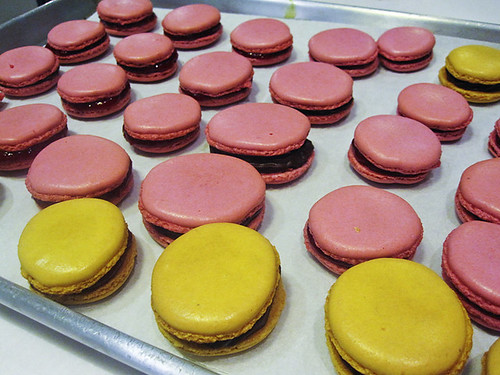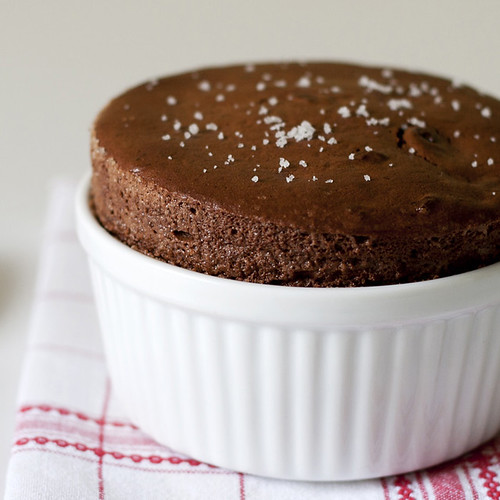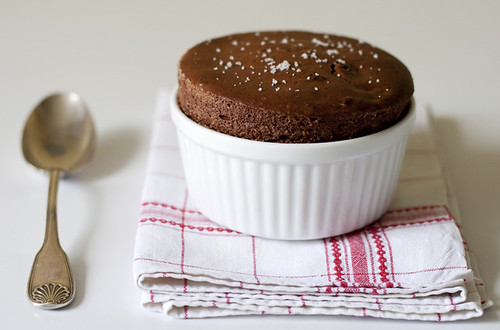If heaven were a dessert (I like to think that my heaven would be full of tasty treats), this would be it. Even Quentin, who doesn't usually like desserts or chocolate, goes into the kitchen to grab himself a spoon. For me, the crispy crackling top, gooey interior surrounded by an airy cake-like exterior and a crystal sugar crust make the soufflé one of the most texturally intriguing things I have ever put in my mouth. Every bite is different. Every bite is delicious.
I always thought that the intimidating soufflé was a little far out of my league. I haven't been cooking for that long, and I've heard horror stories of soufflés that never rose, ones that toppled over into a hot mess, and some that went plummeting once the oven door was opened. I wanted to really test my skills, so I gave it a shot.
I originally got the recipe from
Cooking for Engineers, and the first time I made them, they came out perfectly, with their crisp tops rising above the fluffiness beneath. It wasn't so hard. Maybe I just got lucky. I tried the recipe again. Once more, they came out with their crowns held high. Then I started to experiment with the ingredients. I think that's how a lot of cooks, chefs, and food lovers come up with their own recipes. Test. Tweak. Re-test.

So here's how I came to mine. One day, I tried making them with whole milk (I was out of heavy cream) and cinnamon. I loved the lighter, more airy texture, but the cinnamon gave you too much of the "holiday" feeling, and I just wasn't feeling it. I tried it again, this time with the heavy cream, and a packet of Starbuck's Via instant coffee. It was good, but Starbuck's coffee sometimes leaves me with a burnt taste in the back of my mouth, and it did the same with the soufflés. I recently tested the recipe with instant espresso powder, fleur de sel, and fermented milk (not spoiled milk, actual, bought-from-the-store-fermented milk) just to see what it would do. Yeah, not doing that again. It wasn't horrible, but the fermented milk gave it a tang that was not what I wanted in my soufflé.

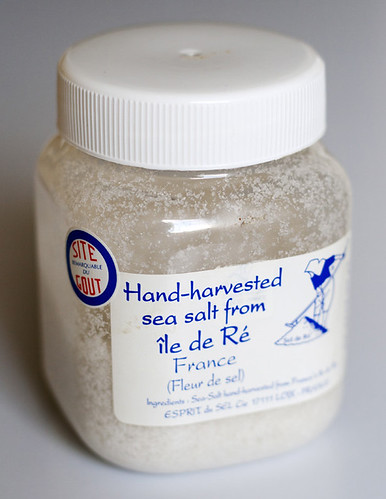
I thought long and hard about what I liked and didn't like about each of my soufflé experiments. I loved the lightness of the soufflés that I made with the whole milk. The instant espresso really brought out the chocolate flavor in another batch I made, and the fleur de sel sprinkled on top were like little flavor bursts that enhanced all of the chocolatey flavors as the salt melted on your tongue. So here it is... my Ultimate Soufflé.
Dark Chocolate Espresso Soufflés
2oz (60ml) whole milk
8oz (230g) dark chocolate, chopped
1 tablespoon (14g) unsalted butter, plus extra for greasing ramekins
1 teaspoon instant espresso powder
1 teaspoon vanilla extract
4 egg yolks
5 egg whites
1/8 teaspoon cream of tartar
1/3 cup (70g) superfine sugar, plus extra for dusting ramekins
fleur de sel, to taste (you can find fleur de sel at many specialty food stores, such as
Williams-Sonoma)
Preheat oven to 375° Fahrenheit (190° Celsius).
Grease the bottom and sides of four (4-inch wide by 2-inch deep) ramekins with butter and dust completely with sugar, being sure to knock off any excess.
Separate the eggs into two bowls, one for the yolks, and one for the whites. Be sure to use the freshest eggs possible, as that will insure fluffy egg whites.
In a double boiler, or a large bowl over a pot of simmering water (make sure bottom of the pot does not touch the water) melt together the butter, milk, chocolate, vanilla, and espresso powder. Remove the bowl from the heat just before the chocolate has completely melted, so as not to scorch the chocolate. Stir until all of the chocolate has melted and let cool for about 3 minutes. Add the egg yolks one at a time and whisk to combine, making sure that all of the yolks are completely incorporated into the batter.
In a large bowl, beat the egg whites and the cream of tartar together with a hand mixer. Once the egg whites start form soft peaks, add the 1/3 cup (70g) of sugar and continue to beat until the egg whites form stiff peaks. *To test for peak stiffness, lift the beaters out of the egg whites and turn upwards, with the beaters facing the ceiling. For soft peaks, the tips of the egg whites will droop. For stiff peaks, the tips of the egg whites will stand pointed and firm.
Add 1/3 of the egg whites into the chocolate mixture and fold gently to combine. Once combined, continue with another 1/3 of the egg whites, again, folding in gently. Add the last 1/3 of the egg whites and without over mixing, fold into the batter.
Pour into ramekins and fill completely to the top. For a nice even top, fill the ramekins a little more than completely full, and use the flat edge of a spatula or back of a knife to even off the top (much like you would do when measuring flour).
Bake in the center rack of the oven for 15 minutes, being sure not to open the oven door until they are finished! Sprinkle the tops of the soufflés with fleur de sel, and serve immediately. Serves 4-8(two can share one).
*On a healthier note, yesterday was day one of my
LifeGreens programme bien être (well-being program). Don't worry, I will still post some cakes and not-so healthy recipes here and there... but since I've moved away from the processed foods and cheeseburger-filled diet that was my life in the States, I've noticed quite a large shift in the way I'm eating. Living in a country where the overall eating mentality is not about counting calories or eating low-fat this or non-fat that, but about the quality and freshness of the food you eat; I have decided to mirror my efforts on eating well, and improving my overall well-being.
My friend Jules, CEO of
LifeGreens, introduced me to his LifeGreens blé en herbe (wheat grass) supplements a few months ago. I noticed the wheat grass trend growing in the States, and it is seems to just now be breaking through here in France. In the States, I've watched people down unappetizing cups of freshly pressed wheat grass like a shot of grain alcohol, nose plugged, eyes closed. Yum. But with smoothie shops and juice bars popping up all over the place here, it's only a matter of time before wheat grass shots become a must-have on the menu.
I was apprehensive about trying Jules' supplements, but he explained to me how his product actually tastes better, and is easier to incorporate into my diet than the unappealing shot of green muck. LifeGreens supplements are winter wheat grass in powdered form, mixed with papaya enzyme, which aides in digestion and absorption by the body. I think the papaya also makes it a little more palatable. You can mix the LifeGreens blé en herbe with fruit juices, in recipes, or just in a glass of cold water. I could go on to explaining the details, but all the information is on the website, so you can check it out
here. To all my non-French speaking readers, sorry! The site is completely in French, but
Google Translate seems to work fairly well.
Day one (yesterday), I had it with a glass of water and a squeeze of fresh lemon juice. Not bad.
This morning, I mixed it in a glass of orange juice... much better.
I'm interested to see how the daily addition of LifeGreens along with healthy eating, exercise (hopefully), and meditation will improve my well-being. Check back to see how I'm doing!

